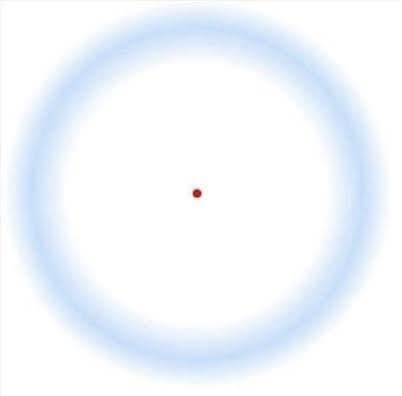There’s a quiet kind of magic in this image.
At first glance, it’s simple: a faint blue circle surrounding a small red dot in the center. But give it a moment—really look. Fix your gaze on the red dot, and something strange happens. The circle begins to fade. Then, almost entirely, it disappears. And yet, you know it’s still there. Your eyes are open. Nothing has changed, and yet everything has.
This is more than an optical illusion. It’s a lesson in perception. And through the lens of Japanese philosophy—particularly ideas like Mushin, Enso, Shikata ga Nai, and Mono no Aware—it becomes something deeper: a meditation on attention, change, and the beauty of the unseen.
The Circle and the Center
Let’s begin with the basics. The image plays on something called Troxler’s fading, a neurological phenomenon discovered in the 1800s. When your eyes fixate on one point, objects in your peripheral vision begin to fade and blend into the background. It’s the brain’s way of filtering out “unnecessary” information. What’s not changing, it deems irrelevant.
But in this case, the fading is precisely what draws our attention. The disappearing circle becomes the message.
In Japanese aesthetics, the concept of Enso (円相)—a hand-drawn circle often created in one brushstroke—symbolizes enlightenment, presence, and the void. Some Enso are open, symbolizing the idea that nothing is ever truly complete. Others are closed, expressing unity and fullness. What’s interesting here is that this blue circle, though softly rendered and seemingly perfect, is undone by the act of focus itself. The more we center ourselves—the more we still the mind—the more the circle dissolves. And maybe that’s the point.
Mushin and the Disappearance of Thought
To fixate on the red dot is to practice a form of Mushin (無心), or “no-mind.” This Zen principle describes a mental state free from distraction, free from ego, free from thought. It’s not about emptiness in the negative sense, but rather a clear space—an unburdened awareness. In martial arts and in meditation, Mushin allows practitioners to respond to the moment without hesitation or cluttered thinking. You become a vessel. A mirror. A presence.
In this image, Mushin becomes visible. When you enter into focus—true, sustained focus—the visual noise of the blue ring vanishes. It’s still there, of course. But your mind, like a calm pond, no longer ripples with its presence. This mirrors what Zen teaches: that the world doesn’t stop, but your need to grasp and interpret it does. And in that release, clarity appears.
Mono no Aware and the Bittersweet Fade
As you continue to watch the red dot, something else creeps in. A kind of quiet sadness. The blue ring is gone, but you remember it. You know what you’ve lost. And in that moment, you feel the ache of Mono no Aware (物の哀れ)—the deep, gentle sorrow that comes from the transience of things.
This awareness isn’t despairing. It’s soft. It’s the feeling you get when cherry blossoms fall, or when a good moment ends. The beauty lies in the passing. The image captures this perfectly: the vanishing ring is a visual metaphor for how moments leave us. Even as we hold focus—perhaps especially when we do—the peripheral beauty slips away.
In Western philosophy, this might be likened to existential awareness or even mindfulness, where presence includes acknowledging that all things are temporary. But Mono no Aware leans into the emotional texture of that realization. It says: Let the circle fade. Feel it as it goes.
Shikata ga Nai and Acceptance of What Is
Why does the ring disappear? Because that’s how we’re built. Because the brain has its own rules. Because the more we try to hold everything at once, the more some things must fall away.
This is the essence of Shikata ga Nai (仕方がない)—“it cannot be helped.” Not in a fatalistic sense, but in a wise, weathered way. Life will shift. Perceptions will fail. Memories will blur. Sometimes, the circle disappears, and you cannot stop it. So instead of clinging, Shikata ga Nai asks us to breathe and allow.
In this image, the fading ring is not a failure of vision—it’s a function of vision. And maybe that’s true in our lives, too. Maybe we don’t have to see everything to be fully present. Maybe holding the center—what matters most—is enough.
The Art of Seeing Less
This brings us to something curious: by focusing more, we actually see less. The outer world vanishes so we can concentrate on the center. That contradiction lies at the heart of many Zen teachings, where fullness is found in emptiness, and awareness is sharpened through simplicity.
In design, minimalism embraces this. In Japanese gardens, empty space (ma) is as important as stone or water. In Western thought, we might compare it to negative space in art, or even to silence in music—the pause that defines the note. The image reminds us that what we don’t see is just as important as what we do. Absence is not empty. It’s intentional.
What Are You Really Looking At?
It’s not just a dot and a circle. It’s a practice.
It’s the moment you pause in the middle of a busy day to focus on a single breath. It’s the quiet hush when a thought fades and something deeper takes its place. It’s the recognition that some things must disappear in order for others to come into view.
This illusion is a visual koan—a Zen riddle that offers no solution, only insight. It doesn’t demand that you understand it. It only asks that you experience it. And in doing so, it opens a window.
Not into some new truth. But into what’s already here.
In the End
The blue ring doesn’t need your attention to exist. It exists on its own terms. And so do the people, moments, and memories in your life. Some are central. Some peripheral. Some fade, not because they are less important, but because your gaze must be somewhere else.
This image, so simple in form, carries within it the seeds of profound awareness: Focus brings clarity. Clarity brings loss. And in loss, we find presence.
Just don’t forget to blink.


Leave a Reply